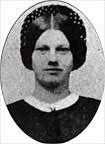
Jenny Wade
Encyclopedia

Gettysburg, Pennsylvania
Gettysburg is a borough that is the county seat, part of the Gettysburg Battlefield, and the eponym for the 1863 Battle of Gettysburg. The town hosts visitors to the Gettysburg National Military Park and has 3 institutions of higher learning: Lutheran Theological Seminary, Gettysburg College, and...
civilian killed directly during the Battle of Gettysburg
Battle of Gettysburg
The Battle of Gettysburg , was fought July 1–3, 1863, in and around the town of Gettysburg, Pennsylvania. The battle with the largest number of casualties in the American Civil War, it is often described as the war's turning point. Union Maj. Gen. George Gordon Meade's Army of the Potomac...
.
The house where she was killed became a popular tourist attraction and museum called the "Jennie Wade House."
Early life
Wade was born in Gettysburg, PennsylvaniaGettysburg, Pennsylvania
Gettysburg is a borough that is the county seat, part of the Gettysburg Battlefield, and the eponym for the 1863 Battle of Gettysburg. The town hosts visitors to the Gettysburg National Military Park and has 3 institutions of higher learning: Lutheran Theological Seminary, Gettysburg College, and...
. She worked as a seamstress with her mother in their house on Breckenridge Street while her father was in a mental asylum. She may have been engaged to Johnston Hastings "Jack" Skelly
Jack Skelly
Johnston Hastings "Jack" Skelly was a Union soldier—a corporal in the 87th Pennsylvania—who died as a result of injuries in the Second Battle of Winchester. He was the friend, and possibly fiancé, of the only civilian to die in the Battle of Gettysburg, Ginnie Wade...
, a corporal in the 87th Pennsylvania, who had been wounded two weeks earlier in the Battle of Winchester. He died from his injuries on July 12, 1863, unaware that Wade had died days earlier.
Casualty of war
Wade, her mother, and two younger brothers left their home in central Gettysburg and traveled to the house of her sister, Georgia Anna Wade McClellan at 528 Baltimore Street to assist her and her newborn child. It was July 1, 1863, during the first day's fightingBattle of Gettysburg, First Day
The First Day of the Battle of Gettysburg during the American Civil War took place on July 1, 1863, and began as an engagement between isolated units of the Army of Northern Virginia under Confederate General Robert E. Lee and the Army of the Potomac under Union Maj. Gen. George G. Meade...
of the Battle of Gettysburg. More than 150 bullets hit the McClellan house during the fighting.
About 8:30 a.m. on July 3, Wade was kneading dough for bread when a Minié ball
Minié ball
The Minié ball is a type of muzzle-loading spin-stabilising rifle bullet named after its co-developer, Claude-Étienne Minié, inventor of the Minié rifle...
traveled through the kitchen door of her sister's house and hit her. It pierced her left shoulder blade, went through her heart, and ended up in her corset. She was killed instantly. While it is uncertain which side fired the fatal shot, some authors have attributed it to an unknown Confederate
Confederate States Army
The Confederate States Army was the army of the Confederate States of America while the Confederacy existed during the American Civil War. On February 8, 1861, delegates from the seven Deep South states which had already declared their secession from the United States of America adopted the...
sharpshooter.
Shortly afterward, three Union soldiers discovered the body and told the rest of the family. They temporarily buried Wade's body in the back yard of the McClellan house, in a coffin originally intended for a Confederate officer. In January 1864, her body was relocated to the cemetery of the German Reformed Church on Stratton Street. On July 4, her mother baked 15 loaves of bread with the dough Wade had kneaded.
Monument
In November 1865, Ginnie Wade's remains were reburied in the Evergreen CemeteryEvergreen Cemetery (Gettysburg, Pennsylvania)
Evergreen Cemetery is a privately-owned rural cemetery near Gettysburg, Pennsylvania, with 5 notable interments: John L. Burns , Steve Courson , Marianne Moore , Eddie Plank , and Oscar Shaw...
near Jack Skelly. A monument to her, designed by Gettysburg resident Anna M. Miller, was erected in 1900 that includes an American flag
Flag of the United States
The national flag of the United States of America consists of thirteen equal horizontal stripes of red alternating with white, with a blue rectangle in the canton bearing fifty small, white, five-pointed stars arranged in nine offset horizontal rows of six stars alternating with rows...
that flies around the clock. (The Betsy Ross House
Betsy Ross House
The Betsy Ross House may be where Betsy Ross lived when she may have made the first American Flag. By 1876, several surviving family members said this was the location....
in Philadelphia is the only other site devoted to a woman to share this distinction of the perpetual flag. The Evergreen Cemetery grave of John L. Burns
John L. Burns
John Lawrence Burns , veteran of the War of 1812, became a 70-year-old civilian combatant with the Union Army at the Battle of Gettysburg during the American Civil War...
also flies the perpetual flag.)

